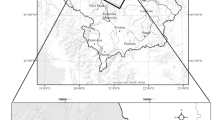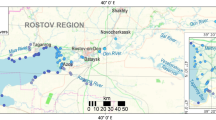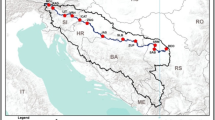Abstract
Purpose
Climate change is contributing to an increase in extreme weather events. This results in a higher river flooding risk, causing a series of environmental disturbances, including potential contamination of agricultural soil. In Serbia, the catastrophic floods of 2014 affected six river basins, including the Kolubara River Basin, as one of the larger sub-catchments of the large regional Sava River Basin, which is characterized by large areas under agricultural cultures, various geological substrates, and different types of industrial pollution. The main aim of this study was to establish the sources of potentially toxic elements in soil and flood sediments and the effect of the flood on their concentrations.
Materials and methods
Field sampling was performed immediately after water had receded from the flooded area in May 2014. In total, 36 soil samples and 28 flood sediment samples were collected. After acid digestion (HNO3), concentrations of the most frequent potentially toxic elements (PTE) in agricultural production (As, Cd, Cr, Cu, Ni, Pb, Zn) and Co which are closely related to the geological characteristics of river catchments, were analyzed. The origin, source, and interrelations of microelements, as well as background values of the PTE of the river catchment, the pollution index (Pi), enrichment factor (Ef), and geological index (Igeo), were determined, using statistical methods such as Pearson correlations, principal component analysis (PCA), and multiple linear regression (MLRA).
Results and discussion
The content of the hot acid-extractable forms of the elements, PCA, and MLRA revealed a heavy geological influence on microelement content, especially on Ni, Cr, and Co, while an anthropogenic influence was observed for Cu, Zn, and Cd content. This mixed impact was primarily related to mines and their impact on As and Pb content. The pseudo-total concentrations of all the analyzed elements did not prove to be a danger in the catchment area, except for Cu in some samples, indicating point-source pollution, and Ni, whose pseudo-total content could be a limiting factor in agricultural production. For the Ef, the Ni content in 59% soil and 68% flood sediment samples is classified into influence classes.
Conclusions
The similar pseudo-total contents of the elements studied in soil samples and flood sediment and their origin indicate that the long-term soil formation process is subject to periodic flooding in the Kolubara River Basin without any significant changes taking place. This implies that floods are not an endangering factor in terms of the contamination of soil by potentially toxic elements in the explored area.








Similar content being viewed by others
References
Adriano DC (2002) Trace elements in terrestrial environments. Biogeochemistry, bioavailability, and risk of metals. Springer-Verlag, Berlin
Alexander EB, Coleman RG, Keeler-Wolfe T (2007) Serpentine geoecology of western North America: geology, soils, and vegetation. Oxford University Press, Cary
Alloway JB (2013) Heavy metals in soil. Trace metals and metalloids in soil and their bioavailability. Springer, Dordrecht
Anderson AJ, Meyer DR, Mayer FK (1973) Heavy metal toxicities: levels of nickel, cobalt and chromium in the soil and plants associated with visual symptoms and variation in growth of an oat crop. Aust J Agrie Res 24(4):557–571. https://doi.org/10.1071/AR9730557
Antić-Mladenović S, Frohne T, Kresović M, Stärk HJ, Tomić Z, Ličina V, Rinklebe J (2017) Biogeochemistry of Ni and Pb in a periodically flooded arable soil: fractionation and redox-induced (im)mobilization. J Environ Manag 186:141–150
Bates BC, Kundzewicz ZW, Wu S, Palutikof JP (2008) Climate change and water. Technical paper of the intergovernmental panel on climate change. IPCC Secretariat, Geneva
Belanovic-Simic S, Perovic V, Vidojevic D, Kostadinov S, Knezevic M, Kadovic R, Kosanin O (2013) Assessment of soil erosion intensity in Kolubara District, Serbia. Fresenius Environ Bull 22(5a):1556–1563
Berrow ML, Reaves GA (1984) Background levels of trace elements in soils. In: Proceedings of the International Conference Of Environmental Of Contamination. CEP Consultants Ltd., Edinburgh, pp 333–340
Brooks RR (1987) Serpentine and its vegetation. A multidisciplinary approach. Dioscorides Press, Portland
Cabral Pinto MMS, Ferreira da Silva EA, Silva MMVG, Melo-Gonçalves P, Candeias C (2014) Environmental risk assessment based on high-resolution spatial maps of potential toxic elements sampled on stream sediments of Santiago, Cape Verde. Geosciences 4(4):297–315. https://doi.org/10.3390/geosciences4040297
Cakmak D, Saljnikov E, Mrvic V, Jakovljevic M, Marjanovic Z, Sikiric B, Maksimovic S (2010) Soil properties and trace elements contents following 40 years of phosphate fertilization. J Environ Qual 39(2):41–547
Cao Y, Zhang D, Shen F, Wang J, Faladysz J, Jarzynska G, Li W, Wang K (2013) As, Cd, Cr, Hg, Ni and Pb in soil from eastern slope of Mt. Gongga, Eastern Tibet, China. Adv J Food Sci Technol 5(6):775–782
Comero S, Vaccaro S, Locoro G, De Capitani L, Gawlik BM (2014) Characterization of the Danube River sediments using the PMF multivariate. Chemosphere 95:329–335. https://doi.org/10.1016/j.chemosphere.2013.09.028
Du Laing G, Rinklebe J, Vandecasteele B, Meers E, Tack FMG (2009) Trace metal behaviour in estuarine and riverine floodplain soils and sediments: a review. Sci Total Environ 407(13):3972–3985. https://doi.org/10.1016/j.scitotenv.2008.07.025
Ðukanović D (2000) Climate of the Valjevo region. Ed. Valjevo Assembly, Valjevo, pp 1–377 (in Serbian)
Erftemeijer PLA, Riegl B, Hoeksema BW, Todd PA (2012) Environmental impacts of dredging and other sediment disturbances on corals: a review. Mar Pollut Bull 64(9):1737–1765. https://doi.org/10.1016/j.marpolbul.2012.05.008
Filipović I (2005) Spatial distribution of geological resources in northwestern Serbia (Jadar block terrane) and its relation to tectonic structures. Annales Géologiques de la Péninsule Balkanique 66:17–20
Geolis, Geological Information System of Serbia (2010) Osnovne geološke karte Srbije 1:100000.Zavod za geološka i geofizička istraživanja Beograd 1959–1966. http://geoliss.mre.gov.rs/
Giri S, Singh AK, Mahato MK (2017) Metal contamination of agricultural soils in the copper mining areas of Singhbhum shear zone in India. J Earth Syst Sci 126:49
Green C, Dieperink C, Ek K, Hegger DLT, Pettersson M, Priest S, Tapsell S (2013) Flood risk management in Europe: the flood problem and interventions (report no D1.1.1), STAR-FLOOD Consortium, Utrecht
Guo Y, Huang CC, Pang J, Zha X, Li X, Zhang Y (2014) Concentration of heavy metals in the modern flood slackwater deposits along the upper Hanjiang River valley, China. Catena 116:123–131. https://doi.org/10.1016/j.catena.2013.12.019
Hutchinson SM, Rothwell JJ (2008) Mobilisation of sediment-associated metals from historical Pb working sites on the River Sheaf, Sheffield, UK. Environ Pollut 155(1):61–71. https://doi.org/10.1016/j.envpol.2007.10.033
Kabata-Pendias A (2011) Soil and plants. CRC Press Taylor & Francis Group, Boca Raton
Krauskopf KB (1979) Introduction to geochemistry, 2nd edn. McGraw-Hill, New York
Lauer J (2008) Flooding impacts on crown growth and yield, University of Wisconsin. Field Crops 28:49–56
Lim WY, Aris AZ, Zakaria MP (2012) Spatial variability of metals in surface water and sediment in the Langat River and geochemical factors that influence their water-sediment interactions. Sci World J 1–14. https://doi.org/10.1100/2012/652150
Liu J, Wang J, Chen Y, **e X, Qi J, Lippold H, Luo D, Wang C, Su L, He L, Wu Q (2016) Thallium transformation and partitioning during Pb−Zn smelting and environmental implications. Environ Pollut 212:77–89. https://doi.org/10.1016/j.envpol.2016.01.046
Martínez-Santos M, Probst A, García-García J, Ruiz-Romera E (2015) Influence of anthropogenic inputs and a high-magnitude flood event on metal contamination pattern in surface bottom sediments from the Deba River urban catchment. Sci Total Environ 514:10–25. https://doi.org/10.1016/j.scitotenv.2015.01.078
Massoura ST, Echevarria G, Becquer T, Ghanbaja J, Leclerc-Cessac E, Morel J (2006) Control of nickel availability by nickel bearing minerals in natural and anthropogenic soils. Geoderma 136(1-2):28–37. https://doi.org/10.1016/j.geoderma.2006.01.008
Milačič R, Zuliani T, Vidmar J, Oprčkal P, Ščančar J (2017) Potentially toxic elements in water and sediments of the Sava River under extreme flow events. Sci Total Environ 605–606:894–905. https://doi.org/10.1016/j.scitotenv.2017.06.260
Mitchell N, Ramos Gomez MS, Guerrero Barrera AL, Yamamoto Flores L, Flores de la Torre JA, Avelar Gonzalez FJ (2016) Contaminated soils and sediments near mining sites in Aguascalientes, Mexico. Bull Environ Contam Toxicol 97(2):216–224. https://doi.org/10.1007/s00128-016-1820-9
Mrvić V, Zdravković M, Sikirić B, Čakmak D, Kostić-Kravljanac L (2009) Toxic and dangerous elements in soil. In: Mrvić et al (ed) Fertility and content of toxic and dangerous materials in soil of Central Serbia Institute of Soil Science Belgrade, pp 75–134 (in Serbian)
Mrvić V, Kostić-Kravljanac L, Čakmak D, Sikirić B, Brebanović B, Perović V, Nikoloski M (2011) Pedogeochemical map** and background limit of trace elements in soils of Branicevo Province (Serbia). J Geochem Explor 109(1-3):18–25. https://doi.org/10.1016/j.gexplo.2010.09.005
Mrvić V, Antonović G, Čakmak D, Perović V, Maksimović S, Saljnikov E, Nikoloski M (2013) Pedological and pedogeochemical map of Serbia. The 1st International Congress on Soil Science XIII National Congress in Soil Science, September 23rd-26th, Belgrade, Serbia. 93-105. UDC: 502.55:631.452
N’guessan YM, Probst JL, Bur A, Probst A (2009) Trace elements in stream bed sediments from agricultural catchments (Gascogne region, S-W France): where do they come from? Sci Total Environ 407(8):2939–2952. https://doi.org/10.1016/j.scitotenv.2008.12.047
O’Neill P (1995) Cadmium. In: Alloway BJ (ed) Heavy metals in soils. Chapman and Hall, London, pp 105–119
Pavlović P, Mitrović M, Djurdjević L (2004) An ecophysiological study of plants growing the fly ash deposits from the ‘Nikola Tesla-A’ thermal power station in Serbia. Environ Manag 33(5):654–663. https://doi.org/10.1007/s00267-004-2928-y
Pavlović P, Kostić N, Karadžić B, Mitrović M (2017) The soils of Serbia. Springer Science+Business Media, Dordrecht. https://doi.org/10.1007/978-94-017-8660-7
Petrović A, Kostadinov S, Dragićević S (2014) The inventory and characterization of torrential flood phenomenon in Serbia. Pol J Environ Stud 23(3):823–830
Quantina C, Ettler V, Garniera J, Sebek O (2008) Sources and extractability of chromium and nickel in soil profiles developed on Czech serpentinites. C R Geoscience 340(12):872–882. https://doi.org/10.1016/j.crte.2008.07.013
Raous S, Echevarria G, Sterckeman T, Hanna K, Thomas F, Martins ES, Becquer T (2013) Potentially toxic metals in ultramafic mining materials: identification of the main bearing and reactive phases. Geoderma 192:111–119. https://doi.org/10.1016/j.geoderma.2012.08.017
Reddy MS, Basha S, Sravan Kumar VG, Joshi HV, Ramachandraiah G (2004) Distribution, enrichment and accumulation of heavy metals in coastal sediments of Alang-Sosiya ship scrap** yard. India. Mar Pollut Bull 48(11-12):1055–1059. https://doi.org/10.1016/j.marpolbul.2003.12.011
Regulation of the Government of the Republic of Serbia on the program of systematic monitoring of soil quality, indicators for the assessment of land degradation and methodology for remediation programs (2010) Government Gazette of the Republic of Serbia. SG RS88/2010: 226–231
Regulations of the Ministry of Agriculture, Forestry and Water management of the Republic of Serbia on allowed amounts of hazardous and noxious substances in agricultural soil and water for irrigation and methods for their testing (1994) Government Gazette of the Republic of Serbia. SG RS 23/94: 553–554
Reimann C, Filzmoser P, Garrett RG (2005) Background and threshold: critical comparison of methods of determination. Sci Total Environ 346(1-3):1–16. https://doi.org/10.1016/j.scitotenv.2004.11.023
Roca N, Pazos MS, Bech J (2012) Background levels of potentially toxic elements in soils: a case study in Catamarca (a semiarid region in Argentina). Catena 92:55–66. https://doi.org/10.1016/j.catena.2011.11.009
Sakan S, Dević G, Relić D, Anđelković I, Sakan N, Đorđević D (2015) Environmental assessment of heavy metal pollution in freshwater sediment, Serbia. Clean Soil Water Air 43(6):794–966
Santos-Araujo SN, Alleoni LRF (2016) Concentrations of potentially toxic elements in soils and vegetables from the macroregion of São Paulo, Brazil: availability for plant uptake. Environ Monit Assess 188(2):92. https://doi.org/10.1007/s10661-016-5100-2
Schiff KC, Weisberg SB (1999) Iron as a reference element for determining trace metal enrichment in Southern California coastal shelf sediments. Mar Environ Res 48(2):161–176. https://doi.org/10.1016/S0141-1136(99)00033-1
Serbian Government Reports on Floods (2014) http://reliefweb.int/report/serbia/serbia-floods-2014
SPSS Statistics for Windows, version 21 (SPSS Inc., Chicago, Ill., USA), about SPSS Inc. http://www.spss.com.hk/corpinfo/history.htm. Accessed 21 Sept 2017
Sterckeman T, Douay F, Proix N, Fourrier H, Perdrix E (2002) Assessment of the contamination of cultivated soils by eighteen trace elements around smelters in the North of France. Water Air Soil Pollut 135(1/4):173–194. https://doi.org/10.1023/A:1014758811194
Summer JK, Wade LD, Engle VD, Malaeb ZA (1996) Normalization of metal concentrations in estuarine sediments from the Gulf of Mexico. Estuaries 19:581–594
U.S. Environmental Protection Agency (1996) Method 3050B. Acid digestion of sediments, sludges, and soils revision 2
Vidmar J, Zuliani T, Novak P, Drinčić A, Ščančar J, Milačič R (2017) Elements in water, suspended particulate matter and sediments of the Sava River. J Soils Sediments 17(7):1917–1927. https://doi.org/10.1007/s11368-016-1512-4
Wei X, Han L, Gao B, Zhou H, Wan X (2016) Distribution, bioavailability, and potential risk assessment of the metals in tributary sediments of Three Gorges Reservoir: the impact of water impoundment. Ecol Indic 61(2):667–675. https://doi.org/10.1016/j.ecolind.2015.10.018
Woitke P, Wellmitz J, Helm D, Kube P, Lepom P, Litheraty P (2003) Analysis and assessment of heavy metal pollution in suspended solids and sediments of the River Danube. Chemosphere 51(8):633–642. https://doi.org/10.1016/S0045-6535(03)00217-0
WRB (2006) World Reference Base for Soil Resources. Food and Agriculture Organization of the United Nations, Rome
Xu Y, Sun Q, Yi L, Yin X, Wang A, Li Y, Chen J (2014) The source of natural and anthropogenic heavy metals in the sediments of the Minjiang River estuary (SE China): implications for historical pollution. Sci Total Environ 493:729–736. https://doi.org/10.1016/j.scitotenv.2014.06.046
Yin S, Lv HJ, Guo YX, Huang WH, Gang L (2013) An analysis of surface soil of city on levels of pollution based on Nemerow index and Geoaccumulation index. China Academic Journal Electronic Publishing House, CNKI, pp 698–701
Acknowledgments
This work was supported by the Ministry of Education, Science and Technological Development of the Republic of Serbia, grant. no. 173018, III 43007, TR 37006.
Author information
Authors and Affiliations
Corresponding author
Additional information
Responsible editor: Dong-Mei Zhou
Electronic supplementary material
ESM 1
(DOCX 28 kb)
Rights and permissions
About this article
Cite this article
Čakmak, D., Perović, V., Antić-Mladenović, S. et al. Contamination, risk, and source apportionment of potentially toxic microelements in river sediments and soil after extreme flooding in the Kolubara River catchment in Western Serbia. J Soils Sediments 18, 1981–1993 (2018). https://doi.org/10.1007/s11368-017-1904-0
Received:
Accepted:
Published:
Issue Date:
DOI: https://doi.org/10.1007/s11368-017-1904-0




